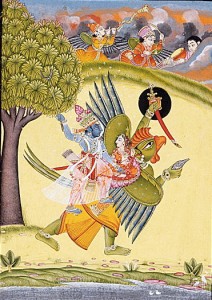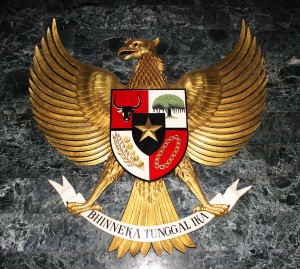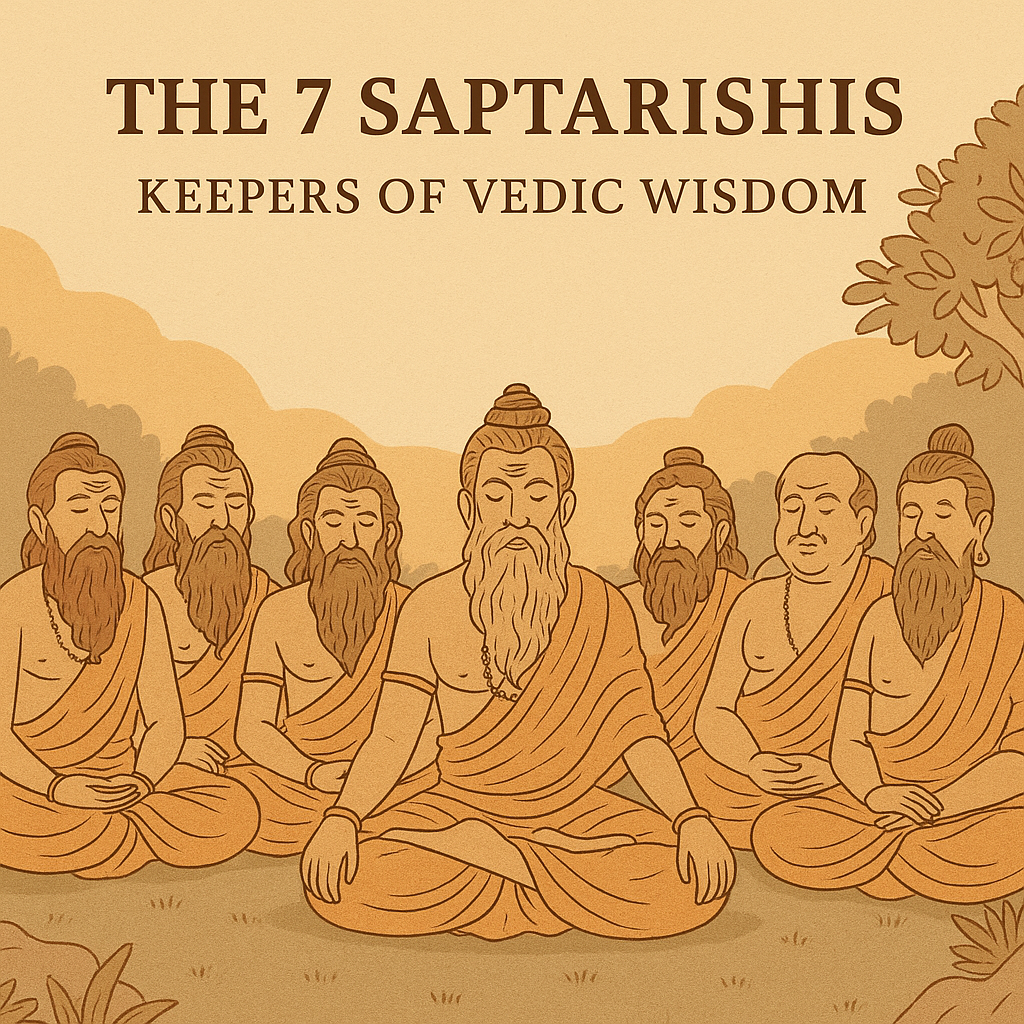in churning the ocean of the Vedas,capturing the very essence of their wisdom.
The Garuda is a large, “mythical” Eagle, which appears prominently in both Hinduism and Buddhism. Incidentally, Garuda is also the Hindu name for the constellation Aquila. The Brahminy kite and Phoenix are considered to be the modern representations of Garuda. Garuda is the national symbol of Indonesia – this mighty creature is depicted as a large Javanese eagle.
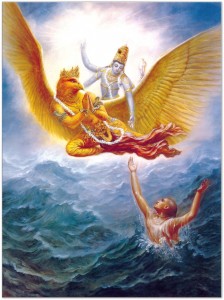 In Hinduism, Garuda is an Upadevata, a divine entity, and is depicted as the vahana or mount of Sri Maha Vishnu. Garuda is usually portrayed as being a strong man; having a golden, glowing body; with a white face, red wings, and an eagle’s beak. He is adorned with a crown on his head. This very ancient deity is believed to have a gigantic form, large enough to block out the Surya Devata or the Sun God.
In Hinduism, Garuda is an Upadevata, a divine entity, and is depicted as the vahana or mount of Sri Maha Vishnu. Garuda is usually portrayed as being a strong man; having a golden, glowing body; with a white face, red wings, and an eagle’s beak. He is adorned with a crown on his head. This very ancient deity is believed to have a gigantic form, large enough to block out the Surya Devata or the Sun God.
Garuda is widely known to be a permanent and sworn enemy of the Nagas, the ones belonging to the serpent race – it is believed that Garuda fed only on snakes. This behavior bears reference to the short-toed Eagle, which can be found in India. The image of Garuda is often worn as a charm or amulet, as it is believed to protect the wearer from snake attacks and poison. In fact, Garuda Vidya is the mantra which is often used as a palliative measure to destroy the ill-effects of snake poison and also to remove all sorts of evil the victim has been afflicted with.
Garuda is generally shown as winding the mighty Adisesha serpent on his left wrist and the serpent Gulika on his right wrist. The great serpent Vasuki winds around him to form his sacred thread. Takshaka, the cobra, winds on his hip to serve as a belt. He wears the serpent Karkotaka as his necklace. Further, the snakes Padma and Mahapadma are his earrings. The serpent Shankachuda adorns his hair as a crown.
Garuda is depicted as flanked by his two wives Rudra and Sukeerthi in an ancient Soumya Keshava temple in Bindiganavile in Karnataka state of India. The Importance of Garuda in Hinduism Garuda’s strong position in Hinduism can be estimated by the fact that two ancient Hindu texts, the Garudopanishad and the Garuda Purana, are both dedicated to him. The Vedas make a mention of Garuda, referring to him as Syena, where this mighty Eagle is adored as the one who brought nectar from heaven to earth. The Puranas also talk about this deed, again equating Garuda with Syena (Sanskrit word for Eagle).
One of the faces of the Panchamukha (five-faced) Hanuman, pointing in the Westerly direction, is that of Mahavira Garuda. Among many Tamil Vaishnava sects, Garuda and Hanuman are referred to as “Periya Tiruvadi” and “Siriya Tiruvadi” respectively.
In the Bhagavad Gita, Krishna, while at the battlefield of Kurukshetra, describes himself as being powerful and omnipresent. He says, “As the son of Vinata, I am the form of Garuda, the King of the birds”.
Krishna and his consort, Satyabhama, are often depicted as riding on Garuda when the former goes to slay Narakasura. Vishnu and Lakshmi are also shown riding Garuda. It is believed that Garuda’s wings chant the Vedas as he flies around the heavens. Garuda has been given various other names, such as Chirada, Khageshwara, Kamayusha, Gaganeshwara, Nagantaka, Kashyapi, Sitanana, Suparna, Tarkshya, Vishnuratha, Vainateya and so on and so forth.
Garuda and Tantra
The Garuda Vyuha is worshipped in Tantra during several Abhichara kriyas, and also used to protect one against Abhichara. Garuda is the Sankarshana energy of the Lord, who is believed to take the manifestation of the omniscient nature of the Lord, during the process of creation. He represents the five vayus that lie within each of us, namely, prana, vyana, udana, samana and brahmana, via each of his five forms, Satya, Supama, Garuda, Tarkshya and Vihageshwara respectively.
The spiritual seeker can attain a stage of Kundalini awakening, resulting in a state of higher consciousness, through the control of these five vayus, with the help of Pranayama.
Birth and Leelas of Garuda
The Mahabharata relates the details of Garuda’s birth. According to this great epic, when Garuda first burst forth from his egg, he appeared as a tremendously brilliant light emitted by a powerful inferno, which could only be equated to the cosmic conflagration that destroys the entire world at the end of every age. Frightened by the sight, the Devas approached Garuda and begged him for mercy. Garuda immediately complied to their request and reduced himself in size and energy.
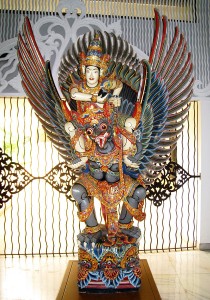 Garuda’s Enmity with the Nagas
Garuda’s Enmity with the Nagas
Garuda was born to the sage Kashyapa and Vinata. Kashyapa was also married to Vinata’s sister Kadru. Kadru gave birth to a thousand snakes, who are considered to be the ancestors of all the snakes that can be found on earth today.
One day, Vinata entered into a petty bet with Kadru, regarding the color of the tail of the divine, seven-headed flying horse, Uchaishravas, who emerged during the episode of the Sagar Manthan (Churning of the Ocean of Milk). Kadru claimed that the color of his tail was black, whereas Vinita claimed it was white. The stake was that whoever lost would become a dasi or slave of the winner. Kadru, who was bent upon winning by any means, asked her sons, the Nagas, to hang onto the tail of the horse, thereby turning it black in color. Thus, the tail which was actually white, turned to black, resulting in Vinata losing the bet and becoming Kadru’s dasi. An arrogant Kadru, along with her sons, treated Vinata very badly, inflicting untold suffering on the latter.
Garuda, enraged by this incident and wanting to release his mother from this bondage, approached the serpents and asked them what he would have to give them in order to purchase her freedom. The Nagas told Garuda that he would have to bring them the Devamrita or Nectar of Immortality in order to free his mother. Garuda knew that this would be a very difficult task to accomplish, as the Devas zealously guarded this elixir, as it was the very source of their everlasting youth and immortality.
The nectar was protectively surrounded on all sides with a fire that covered the entire sky. It was also impossible to access it from above, because it was blocked by means of a fierce-looking and dangerous contraption of sharp rotating blades. Additionally, two gigantic poisonous snakes had been stationed next to the elixir, to further guard it.
Not easily daunted, Garuda surveyed his situation and hastened toward the abode of the Devas, with the intent of stealing the amrita. However, already knowing of his intention, the Gods waged a war against him. Garuda fought valiantly and defeated the entire army and scattered them around in all directions.
He then gathered the water of many rivers in his mouth and poured them onto the protective fires, extinguishing them in one go. Then, making himself really miniscule in size, he swooshed past the rotating blades and entered the area where the amrita was kept. Indulging in battle with the poisonous snakes, he defeated and mangled the two creatures as well. Then, taking the pot of amrita in his mouth, he leapt into the air and headed toward the Nagas who had kept his mother under their control.
En route, Vishnu appeared before him. However, the two did not enter a fight and instead, exchanged promises. Vishnu promised Garuda of immortality without even drinking from the amrita. Garuda, on his part, promised Vishnu that he would become the latter’s mount.
Further ahead, Garuda met Indra and there was another exchange of promises here as well. Garuda promised Indra that once he had delivered the elixir to the Nagas, he would then ensure that Indra regained possession of the Devamrita. Indra, in turn, promised to give Garuda the serpents as food.
Reaching the land of the Nagas, Garuda placed the pot containing the elixir on the grass, and requested them to liberate Vinata from her servitude. He also requested the serpents to perform certain religious rites before going ahead and consuming the Devamrita.
As the Nagas hurried off to perform the said rites, Indra rushed to the place and took away the pot containing the amrita. When the serpents returned, they were aghast to see that the elixir was missing. However, there were small droplets of it on the grass, which they tried to lick off. This made their tongues split in two. Legend has it that this explains why snakes have split tongues and why they also shed their skin as a sign of immortality.
After having fulfilled his mission, Garuda went on to fulfill his promise made to Vishnu. From then on, Garuda became Vishnu’s vahana and also destroyed his perpetual enemies – snakes – whenever he got an opportunity to do so.
Other Legends Related to Garuda
- A sparrow once laid her eggs on a sea shore, but the waves carried away the eggs deep into the sea. Very upset by the incident, she asked the ocean to return her eggs. When the ocean did not respond, she single-mindedly started picking out the water in her tiny beak, ignoring the taunts from all around. Garuda heard about the sparrow’s massive effort and feeling compassion for her, proceeded to help her. Reaching beside the little sparrow, Garuda ordered the ocean to return her eggs, threatening of dire consequences otherwise. The ocean, frightened by Garuda’s threat, returned the eggs safely to the happy, grateful, sparrow.
- The flapping wings of Garuda are believed to have formed the basis of the Sama Veda. The two wings of this divine, transcendental Prince of all Divine Vahanas, are believed to be the two branches of the Sama Veda, known as Brihat and Rathantara. Garuda vibrated the Sama Veda to pacify and calm his Lord Vishnu.
- Garuda always accompanied his Lord on his most important missions. The mighty bird carried Vishnu to Gajendra, the King of Elephants, when the Lord wanted to save him from the clutches of the deadly crocodile that held onto one of his legs. Vishnu eventually killed the crocodile, thus rescuing Gajendra.
- During the Sagar Manthan episode, Vishnu placed the Mandara Mountain on Garuda’s back. He then sat himself on the bird’s back and asked him to take them to the middle of the ocean. Garuda also placed the mountain in the spot as instructed by Vishnu. Vishnu then requested Garuda to leave, as Vasuki, the serpent King, would not enter the region otherwise, fearing Garuda’s presence. Once Garuda left, Vasuki was brought in to act as the churning rod to churn the mighty ocean.
- Garuda had great love and devotion for Lord Krishna, an avatar of Lord Shri Maha Vishnu. Lord Indra once sent torrential rain over Vrindavana, the abode of Krishna. It is believed that Garuda, who observed the incident from over the clouds, was so angry and frustrated at Indra’s actions, that he started perspiring profusely.
- In another instance, Krishna was fighting with the poisonous snake, Kaliya, trying to subdue him by dancing on his heads. Infuriated by Kaliya’s insolent attitude towards Krishna, Garuda wanted to kill and devour the snake immediately. However, Garuda stopped himself only out of respect for his Lord. Even Krishna warned Kaliya, saying that Garuda would have been powerful enough to kill him, but would not do so only because he saw Krishna’s foot marks on Kaliya’s head.
- Once, when Krishna was fighting Brahmasura and his army, Garuda helped his Lord by pecking at the horses and elephants; scratching and gnawing at them with his beak; disturbing them with his swooshing wings. Overwhelmed by the great bird, the animals finally left the battlefield, leaving Brahmasura to fight alone. The asura (demon), realizing Garuda’s great power, struck the bird with all his strength. However, Garuda did not feel even the slightest impact and continued to support his Lord till he won against the asura.
Descendants of Garuda
The Mahabharata states that Garuda has six sons, who gave rise to the entire race of the birds. The members of this race were believed to be very strong and mighty, also completely lacking compassion. They subsisted on snakes, just as their predecessors did and were all under the protection of Shri Maha Vishnu.
Garuda as a Symbol
All through the Mahabharata, Garuda is known to be an impetuous, violent force to reckoned with. He was supremely powerful, able to move at a great speed and also very well-versed in the martial arts. In fact, the most powerful warriors and fighters are likened to Garuda who swoops down on a serpent. Acharya Drona developed an entire military formation and named it after the mighty bird, Garuda. Garuda also features prominently on Krishna’s banner during the Kurukshetra War.
Garuda in Buddhism
In Buddhism, the clan of the Garuda, also referred to as Garula in Pali, is made up of huge, gigantic predatory birds, with a high degree of intelligence and a capacity of organization. Yet another name for Garuda in Buddhism is Supanna, which literally means, “well-winged” or “having huge wings”. This species, along with the Nagas, combine characteristics of both human beings and animals and may even feature among the lower class of Devas.
Garuda’s wings are believed to be so huge that they span several miles. It is said that the flapping of Garuda’s wings was enough to create hurricane-like winds, which darkened the skies and destroyed houses. The sheer power of Garuda’s wings, it is believed, would be capable of entirely uprooting enormous banyan trees. An average human being could comfortably hide in Garuda’s plumage, without ever being found till he stepped out by himself.
In Buddhism, Garudas are golden-winged Peng birds, who have the special power of changing their size and appearing or disappearing at will. These Peng birds have the power to gulp down entire oceans and level mountains with the swoosh of just one of their wings.
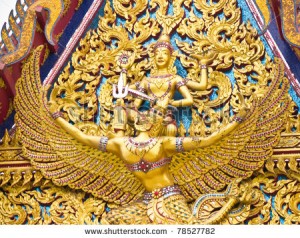 The Garuda Kings of Buddhism
The Garuda Kings of Buddhism
According to Buddhism, there were four Garuda kings, namely, the Great-Power-Virtue Garuda-King, the Great-Body Garuda-King, the Great-Fulfillment Garuda-King, and the Free-At-Will Garuda-King. Each of these four kings were always accompanied by tens of thousands of attendants.
These Garudas, according to the faith, have their own kings and cities. Some of them have the supernatural power of changing their form and morphing into human forms as and when they wish. Some Garuda kings even had romantic dalliances with human women while they were in human form. The dwellings of these Garudas are in the groves of the simbali, or in silk-cotton trees.
Like in Hinduism, the Garudas in Buddhism too are sworn enemies of the Nagas, who are serpentine or dragon-like creatures. The Garudas are in constant search for these Nagas, who they hunt down and kill.
The Garudas, at one time, used to seize the Nagas by their heads. However, the Nagas learned in due course of evolution that they could escape the former by swallowing up large stones, thereby making themselves too heavy for the Garudas to carry. The Garudas that would successfully carry them in their beaks would eventually exhaust all their energy and eventually die of the strain. The Garudas learnt about this trick from the ascetic Karambiya, who also told them to grasp a Naga by its tail, which would force it to throw out the stone it had swallowed.
The Importance of the Garudas in Buddhism
The Garudas enjoy an important status in Buddhism as well. These powerful beings were appointed by Sakra to protect Mount Sumeru and the Trayastrimsa heaven from the attacks of asuras.
The Mahasamyatta Sutta relates that the Buddha once tried to make temporary peace between the Nagas and the Garudas.
The Thai portrayal of Khrut and his quest for the elixir is based on the legend of Garuda, the invincible one. Even Narai (the Thai version of Vishnu) was unable to subdue him. Eventually, Narai entered a truce with Garuda, in order to retain the peace of the heavens. He promised Garuda that once he attained his place in the heavens, he would place Garuda in a prominent position, atop Narai’s residence. His only condition was that Garuda should serve as his vehicle, for all time.
The word Garuda has been modified and used in several Asian countries to denote a similar divine being. In Burmese, the Garudas are called Galone – this creature is the vehicle of the Sunday planet in Burmese astrology. In Japanese, a Garuda is referred to as Karura. In the Kapampangan language used in Philippines, the word for eagle is Galura. In Chinese, Garuda is referred to as the Great Peng, the Golden-Winged Illumination King.
In Mongolia, the Garuda is referred to as the Khan Garuda or Khangarid. Interestingly, before beginning a wrestling match, the participants perform a ritual of taking a hawk-like stance, just before commencing the bout.
The Story of Yue Fei related how Garuda was perched atop the Buddha’s throne. When he spies a celestial bat circling the area, he kills her and is expelled from paradise for his misdeed. He is then reborn as the Song Dynasty General Yue Fei and the bat is reborn as Lady Wang, wife fo the Prime Minister Qin Hui, who eventually turns traitor and finally becomes instrumental in carrying out a political execution of Yue. In this legend, there is a mention of Yue Fei defeating a magic serpent, also transforming into a supernatural spear which he uses all through his military tenure. Interestingly, Yue Fei’s style name in the legend is Pengju.
Garuda, a Veritable Cultural Symbol of Asia
In India, Indonesia and much of Southeast Asia, the Garuda is a veritable national and cultural symbol.
- Garuda is also the National Emblem of Indonesia and Thailand. While the Indonesian Garuda is so rendered to resemble the real Javan Hawk-eagle, the Thai Garuda is portrayed in the traditional style.
- In India, the figure of Garuda is used as a military symbol. The Garud Commando Force is a Special Forces unit of the Indian Air Force, which specializes in carrying out operations behind enemy lines.
- The Brigade of the Guards of the Indian Army also uses the great Garud as their symbol.
- The elite bodyguards of the medieval Hoysala kings in Karnataka were often referred to as Garudas, as they served the king with the same dedication and devotion that Garuda served Vishnu.
- The State Transport systems of both Andhra Pradesh and Kerala use the name Garuda for their Volvo buses.
Garuda in Indonesia
- In Indonesia, the Garuda Pancasaila is the national symbol. This being somewhat resembles the concept of the great Phoenix. The Garuda Pancasaila is golden in color and symbolizes the greatness of the nation. The Garuda Pancasaila has two wings, with seventeen feathers on each wing, eight on the lower tail, nineteen on the upper tail and forty-five on the neck. This symbolism represents the date of Indonesian independence, which is 17 August, 1945. The shield depicted on the emblem of the Pancasaila signifies self-defence.
- Incidentally, the national airline of Indonesia is Garuda Indonesia.
- The Indonesian Armed Forces peacekeeping mission at the United Nations is known as Pasukan Garuda or Garuda Contingent.
- The Airlangga University, one of the oldest universities in Indonesia, uses the Garuda as its emblem. The emblem is called the “Garudamukha” and reveres Garuda as the bearer of knowledge, carrying a jug of amrita, the water of immortality and eternity.
- The Garuda is a cultural symbol in Bali and Java. Statues and masks of Garuda are much sought-after artifacts and tourist souvenirs in these regions.
- The tallest statue of Garuda, which is 18 meters high, can be found at Bali. This awe-inspiring effigy, which is located in the Garuda Wisnu Kencana complex, is made entirely of copper and brass.
- In international games, the national Indonesian football team is called the Garuda Team. Further, the logo of 2011 Southeast Asian Games held in Palembang and Jakarta portrays a stylized, contemporary version of a figure that resembles Garuda.
- The logo of the Wonderland Indonesia tourist campaign too is made up of similar brush strokes, resembling the image of Garuda Pancasaila.
Garuda in Thailand
- The Khrut (or the Garuda) is the national symbol of Thailand.
- A symbol of the royal family in Thailand is the Khrut Pha, which literally means, “Garuda, the Vehicle”.
- Many Buddhist temples in Thailand contain images and statues of Garuda. Hence, the great bird has become a cultural symbol of Thailand.
Garuda in Mongolia
- The Khangarid is the symbol of Ulan Bator, the capital of Mongolia.
- It is believed that Khangarid is the mountain spirit of the Bodg Khan Uul range, who had turned a Buddhist follower during his lifetime on earth. He is now believed to be guarding the mountain range, also emerging as a symbol of honesty and courage.
- The soccer team of the Mongolian Premier League is named Khangarid, after Garuda.
~ Priya Viswanathan, a teacher/performer of Bharata Natyam, Classical Music and Classical Instrumental Veena. A recipient of several awards for both music and dance, Priya is also a freelance writer online.


